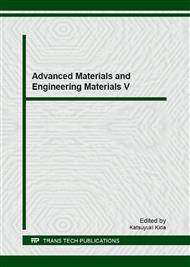[1]
J. Stejskal, I. Sapurina, M. Trchová, Polyaniline nanostructures and the role of aniline oligomers in their formation, Prog. Polym. Sci. 35 (2010) 1420-1481.
DOI: 10.1016/j.progpolymsci.2010.07.006
Google Scholar
[2]
Z. Liu, X. Zhang, S. Poyraz, S.P. Surwade, S.K. Manohar, Oxidation Template for Conducting Polymer Nanoclips, J. Am. Chem. Soc. 132 (2010) 13158-13159.
DOI: 10.1021/ja105966c
Google Scholar
[3]
A.G. Macdiarmid, Polyaniline and polypyrrole: Where are we headed?, Synth. Met. 84 (1997) 27-34.
DOI: 10.1016/s0379-6779(97)80658-3
Google Scholar
[4]
J. Huang, S. Virji, B.H. Weiller, R.B. Kaner, Polyaniline Nanofibers: Facile Synthesis and Chemical Sensors, J. Am. Chem. Soc. 125 (2003) 314-315.
DOI: 10.1021/ja028371y
Google Scholar
[5]
A. Gruger, A. Novak, A. Régis, P. Colomban, Infrared and Raman study of polyaniline Part II: Influence of ortho substitutents on hydrogen bonding and UV/Vis-near-IR electron charge transfer, J. Mol. Struct. 328 (1994) 153-167.
DOI: 10.1016/0022-2860(94)08368-1
Google Scholar
[6]
J. Stejskal, I. Sapurina, M. Trchová, E.N. Konyushenko, Oxidation of Aniline: Polyaniline Granules, Nanotubes, and Oligoaniline Microspheres, Macromolecules 41 (2008) 3530-3536.
DOI: 10.1021/ma702601q
Google Scholar
[7]
Y. Harima, K. Sanada, R. Patil, Y. Ooyama, H. Mizota, J. Yano, Monodisperse and isolated microspheres of poly(N-methylaniline) prepared by dispersion polymerization, Eur. Polym. J. 46 (2010) 1480-1487.
DOI: 10.1016/j.eurpolymj.2010.04.017
Google Scholar
[8]
L. Zhang, H. Peng, J. Sui, C. Soeller, P.A. Kilmartin, P. J. Travas-Sejdic, Self-Assembly of Poly(o-methoxyaniline) Hollow Microspheres, J. Phys. Chem. C. 113 (2009) 9128-9134.
DOI: 10.1021/jp900267t
Google Scholar
[9]
R.B. Kaner, H.D. Tran, A general synthetic route to nanofibers of polyaniline derivatives, Chem. Commun. 37 (2006) 3915-3917.
DOI: 10.1039/b605928g
Google Scholar
[10]
Y. Izumi, R. Hasebe, K. Urabe, Catalysis by heterogeneous supported heteropoly acid, J. Catal. 84 (1983) 402-409.
DOI: 10.1016/0021-9517(83)90011-8
Google Scholar
[11]
W. Li, L. Li, Z. Wang, A. Cui, C. Sun, J. Zhao, 12-tungstophosphoric heteropolyacid anions encapsulated in chemically modified mesoporous silica FSM-16 and its electrocatalytic reduction for nitrite, Mater. Lett. 49 (2001) 228-234.
DOI: 10.1016/s0167-577x(00)00375-x
Google Scholar
[12]
M. Barth, M. Lapkowski, S. Lefrant, Electrochemical behaviour of polyaniline films doped with heteropolyanions of Keggin structure, Electrochimica Acta 44 (1999) 2117-2123.
DOI: 10.1016/s0013-4686(98)00319-3
Google Scholar
[13]
M. Hasik, A. Pron, J. Poźniczek, A. Bielański, Z. Piwowarska, K. Kruczala, R. Dziembaj, Physicochemical and catalytic properties of polyaniline protonated with 12-molybdophosphoric acid, J. Chem. Soc. Faraday Trans. 90 (1994) 2099-2106.
DOI: 10.1039/ft9949002099
Google Scholar
[14]
K. Nomiya, T. Takahashi, T. Shirai, M. Miwa, Anderson-type heteropolyanions of molybdenum(VI) and tungsten(VI), Polyhedron. 6 (1987) 213-218.
DOI: 10.1016/s0277-5387(00)80791-3
Google Scholar
[15]
E. Jin, X. Bian, X. Lu, L. Kong, C. Wang, W. Zhang, Facile synthesis of polyaniline derivatives hollow microspheres with porous shells deposited on glass substrate, Mater. Chem. Phys. 120 (2010) 336-340.
DOI: 10.1016/j.matchemphys.2009.11.012
Google Scholar
[16]
C. Luo, H. Peng, L. Zhang, G.L. Lu, Y. Wang, J. Travas-Sejdic, Formation of Nano-/Microstructures of Polyaniline and its Derivatives, Macromolecules 44 (2011) 6899-6907.
DOI: 10.1021/ma201350m
Google Scholar
[17]
Z. Liu, Y. Zhu, L. Wang, C. Ding, N. Wang, M. Wan, L. Jiang, Polyaniline Microtubes with a Hexagonal Cross-Section and pH-Sensitive Fluorescence Properties, Macromol. Rapid. Commun. 32 (2011) 512-517.
DOI: 10.1002/marc.201000638
Google Scholar


